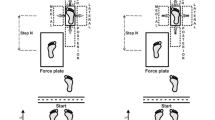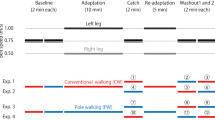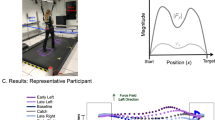Abstract
Adaptive human locomotion is dependent on safe clearance of obstacles encountered in the path of locomotion. When the terrain is uneven or compliant, stability along with safe obstacle clearance are competing demands presented to the central nervous system (CNS). To examine how the CNS deals with the two competing demands, six participants walked under four conditions: normal ground walking, normal ground walking with an obstacle in the travel path, compliant surface walking, and compliant surface walking with an obstacle in the travel path. Full body kinematics were measured and swing limb kinetics were derived from these measurements. Results showed that on a compliant surface, the CNS was able to decrease foot placement variability at foot contact when approaching an obstacle, similar to the normal ground terrain. Limb trajectory over the obstacle showed that toe elevation was maintained while clearance over the obstacle was lower in the compliant surface condition due to depression of the surface during push off. This illustrates that the CNS controls toe elevation, not toe clearance when stepping over an obstacle. Work done in the knee during elevation and hip during lowering was similar in the compliant and ground conditions even though a lower clearance over the obstacle was achieved in the complaint condition. This shows the inability of the CNS to account for compression of the surface prior to obstacle clearance and provides further evidence the CNS controls toe elevation, not clearance when stepping over an obstacle.





Similar content being viewed by others
References
Begg RK, Sparrow WA, Lythgo ND (1998) Time-domain analysis of foot-ground reaction forces in negotiating obstacles. Gait Posture 7:99–109
Chou L, Draganich LF (1998) Placing the trailing foot closer to an obstacle reduces flexion of the hip, knee, and ankle to increase the risk of tripping. J Biomech 31:685–691
Ferris DP, Liang K, Farley CT (1999) Runners adjust leg stiffness for their first step on a new running surface. J Biomech 32:787–794
Hardin EC, van den Bogert AJ, Hamill J (2004) Kinematic adaptations during running: effects of footwear, surface, and duration. Med Sci Sports Exerc 36:838–844
Hill SW, Patla AE, Ishac MG, Adkin AL, Supan TJ, Barth DG (1999) Altered kinetic strategy for the control of swing limb elevation over obstacles in unilateral below-knee amputee gait. J Biomech 32:545–549
Hof AL, Gazendam MGJ, Sinke WE (2005) The condition for dynamic stability. J Biomech 38:1–8
Lee DN, Lishman JR, Thomson JA (1982) Regulation of gait in long jumping. J Exp Psychol Hum Percept Perform 8:448–459
MacLellan MJ, Patla AE (2006) Adaptations of walking pattern on a compliant surface to regulate dynamic stability. Exp Brain Res (in press)
Marigold DS, Patla AE (2005) Adapting locomotion to different surface compliances: neuromuscular responses and changes in movement dynamics. J Neurophysiol 94:1733–1750
Moritz CT, Farley CT (2004) Passive dynamics change leg mechanics for an unexpected surface during human hopping. J Appl Physiol 97:1313–1322
Niang AE, McFadyen BJ (2004) Adaptations in bilateral mechanical power patterns during obstacle avoidance reveal distinct control strategies for limb elevation versus limb progression. Motor Control 8:160–173
Patla AE (2003) Strategies for dynamic stability during adaptive human locomotion. IEEE Eng Med Biol Mag 22:48–52
Patla AE, Greig M (2005) Stop and go locomotion over an obstacle under no vision is less successful due to higher initial foot placement variability. Gait Posture 21(Suppl 1):S26
Patla AE, Prentice SD (1995) The role of active forces and intersegmental dynamics in the control of limb trajectory over obstacles during locomotion in humans. Exp Brain Res 106:499–504
Patla AE, Rietdyk S (1993) Visual control of limb trajectory over obstacles during locomotion: effect of obstacle height and width. Gait Posture 1:45–60
Patla AE, Prentice SD, Robinson C, Neufeld J (1991) Visual control of locomotion: strategies for changing direction and for going over obstacles. J Exp Psychology 17:603–643
Winter DA (2005) Biomechanics and motor control of human movement. Wiley, Hoboken, NJ
Acknowledgments
Michael Greig and Daniel Marigold are thanked for their insight and support during the course of this study. Funding support is appreciated through NSERC and OGS.
Author information
Authors and Affiliations
Corresponding author
Additional information
An erratum to this article can be found at http://dx.doi.org/10.1007/s00221-006-0493-8
Rights and permissions
About this article
Cite this article
MacLellan, M.J., Patla, A.E. Stepping over an obstacle on a compliant travel surface reveals adaptive and maladaptive changes in locomotion patterns. Exp Brain Res 173, 531–538 (2006). https://doi.org/10.1007/s00221-006-0398-6
Received:
Accepted:
Published:
Issue Date:
DOI: https://doi.org/10.1007/s00221-006-0398-6




